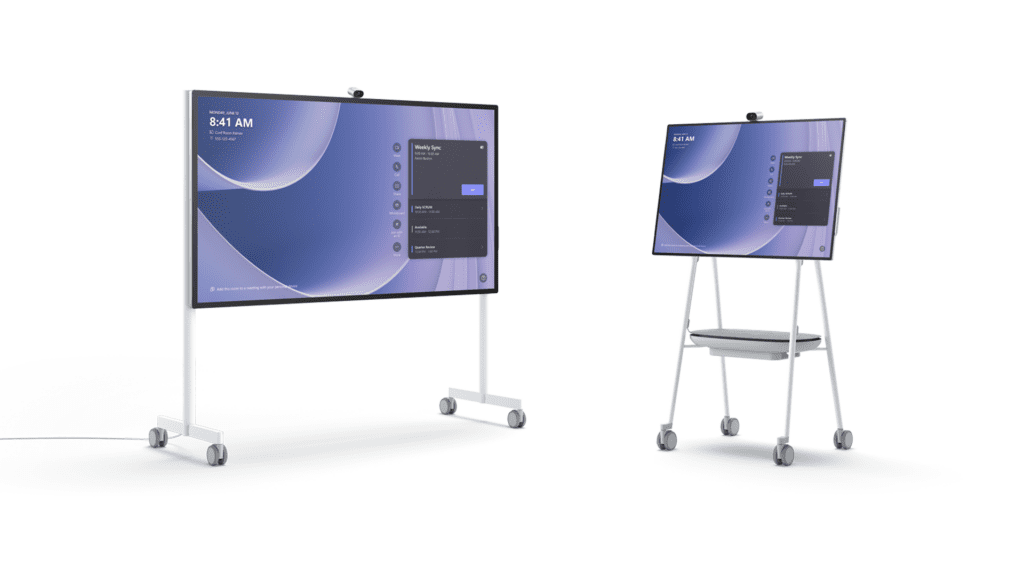
How far Surface Hub has come! First released in 2016 and targeted to businesses, Surface Hub was then described as an “ambitious gambit to reimagine how meetings happen” and one that paid off. Today, you can find a Surface Hub standing tall and impressive in meeting rooms, conference and board rooms, and even event spaces. It’s in industries as diverse as healthcare, education, manufacturing, financial services, and particularly the public/government sector.
For those unfamiliar, Surface Hubs are wall-mounted or roller-stand-mounted devices measuring a whopping 50 or 85-inch (at least for Hub 3 models) and feature touchscreens with multi-touch and multi-pen capabilities. These unique specs come together to create a collaborative canvas and meeting device that allows teams – remote, in-person or any combo – to whiteboard ideas, contribute to projects, and connect dynamically with engaging video conferencing experiences.
Given the pioneering nature of Surface Hub, Microsoft has taken close note of user analytics and requests and engineered the latest generation device accordingly. The biggest change is probably the operating system – the original Hub devices had a custom kiosk operating system, allowing it to function as both a video conferencing unit and mobile display unit for email or document review. Surface Hub 3 now runs Windows 10 or 11 IoT and as such support and management is much more streamlined with the rest of your windows fleet.
In addition, some long-requested features have been added that will no doubt excite Surface Hub fans and those newer to the seamless Hub experience – and on the flipside, some lesser-used features have been dropped. Let’s take a closer look.

Microsoft has upgraded the operating system on the Surface Hub to Windows 10 IoT. This is the same operating system found on Windows-based Teams Rooms devices. This makes deployment, management, and monitoring Surface Hubs much simpler, and brings management of the devices into the same space as all other Teams Rooms devices.
Microsoft has significantly amped up processing power with the 7-year-old i5 with 8GB RAM replaced with a 32GB RAM and i7 processor to deliver an impressive 60% increase – of note is that graphics performance has soared by 160% when compared to its predecessor. These improved specs not only provide more power but also position the device to harness future software innovations as they arrive.
Like its predecessor, Surface Hub 3 continues to stand out with its high-resolution 4K PixelSense display, complemented by an anti-glare coating that ensures content remains visible regardless of lighting conditions and viewing angles. There are also still two microphone arrays and a pair of speakers supported by smart AV technologies that boost audio based on the device’s portrait or landscape orientation.
Surface Hub 3 comes with the Microsoft Teams Rooms on Windows experience. To join a Microsoft Teams meeting, just walk up to the screen and one-touch will start the interaction, optimised to the screen size. The same goes for Zoom or Webex meetings. Images and video appear crisp and clear on the brilliant 4K screen with high resolution and graphics performance.
Remote viewers get a better, more inclusive viewing experience too. The Surface Hub Smart Camera with its ultra-wide field of view of 136 degrees, high-quality glass optics, and a low light sensor allows remote meeting attendees to clearly see people interact with content on Surface Hub while simultaneously viewing everyone else in the room. This is a big step up from the previous fisheye camera of the original.
A new feature called Cloud IntelliFrame further enhances the Teams Rooms meeting experience with a smart video feed that removes backgrounds, adjusts video sizes, and separates people so remote attendees blend seamlessly with in-person attendees.
On-device collaboration has become even more immersive with active inking for up to two Surface Hub Pens or Surface Slim pens simultaneously, providing 20 points of multitouch and built-in palm rejection for a natural interaction experience.
Microsoft Copilot in Whiteboard further ramps up collaborative efforts in Microsoft Teams meetings by using AI to help generate and organise ideas, create designs, or summarise whiteboard content, all with the goal of creating more engaging and efficient meetings.
Surface Hub 3 is available in either 85-inch or 50-inch. The big bonus for the smaller model is that it spins. Just like a smartphone, it has the ability to physically rotate through both portrait and landscape modes while the layout updates automatically, allowing for more natural one-on-one calls or whiteboarding sessions.
In general, the Surface Hub 3 85-inch is best for larger conference or board rooms, while the smaller 50-inch model is ideal for more intimate spaces, or more mobile applications. Specifically, the 50-inch model comes with a Steelcase Roam Stand making it fully mobile (plus a variety of stands and wall-mounting options from the Designed for Surface range). Adding to the smaller model’s mobility is the APC Charge Mobile Battery, which allows the device to be unplugged and taken virtually anywhere in the building.
IT administrators retain full control and ensure compliance with the Surface Hub 3 by managing settings and policies centrally through Microsoft Endpoint Manager. They can actively monitor room health status using Microsoft Teams Admin Center and the Pro Management Portal.
Meanwhile, Windows provides enterprise-grade security, allowing IT admins to enforce data protection through BitLocker and Trusted Platform Module 2.0 (TPM). There’s also cloud-powered security via Microsoft Defender, to enhance overall device security and management.
As we mentioned earlier, there are a few features that have been removed from the Surface Hub 3:
It’s also worth noting that Surface Hub 2S customers can retain their hardware and elevate their experience by adding the above features with a Surface Hub 3 Pack. The cartridge will unlock the Surface Hub 3’s enhanced features, including Smart Rotation on the smaller Hub.
We expect Surface Hub 3 to hit the shelves in late November 2023.
Data#3 is your go-to partner for end-to-end support, maintenance and training for all your Surface fleet requirements. Request a virtual walkthrough to see how we can transform your team with the Surface suite at the best possible prices, or pre-order ready for when stock hits the shelves next month.